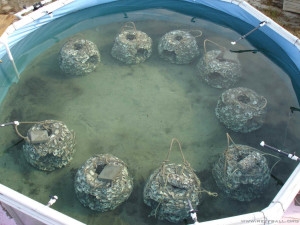
Although mud crab feeding was inhibited in the presence of both toadfish and stone crabs, estimated non-consumptive effects (NCEs) were weaker for stone crabs in the MPE experiment. Consumption of oysters and mud crabs by the intra-guild stone crab was undeterred by the presence of toadfish. The classic tri-trophic cascade formed by the toadfish-mud crab-oyster configuration was potentially weakened by several interactions within the MPE experiment. Additionally, a complimentary set of trait-mediated-indirect interaction (TMII) experiments examined the inhibition of oyster consumption relative to mud-crab size and top predator identity in the absence of other cues and factors. To examine factors affecting the stability of the classic tri-trophic oyster reef cascade within a different context, configurations of three predators, including the Gulf toadfish, Gulf stone crab, and oystershell mud crab, were manipulated together with either oyster shell or limestone gravel substrate within a multiple predator effects (MPE) experiment. How interactions among multiple predators affect the stability of trophic cascades is a topic of special ecological interest. Even so, as yet unknown is the possible reduction in performance in situ of smaller particles that might occur if they increase the one-dimensionality of the plant. In this case, the a priori expectation that oyster shell would outperform limestone did not materialize because of the quantity of small limestone particles of favorable shapes in the deployed material. Analysis of a Louisiana limestone plant and associated oyster cultch showed that the proportion of small and large limestone particles and the relative proportion of whole shells and fragments can greatly alter expSA/V. Nevertheless, the higher variability in expSA/V of shell and other factors such as the expected lifetime and the relative performance of small and large particles of materials should also be considered. Thus, shell is likely to be a more efficient material than limestone for recruitment enhancement. For limestone of similar particle size to provide an equivalent recruitment benefit for the same cost would require that the cost of purchase, transport, and planting be three to nine times lower than shell. Mean expSA/V ratios of shell were approximately three to nine times higher than limestone. Shell (including whole shell and fragments) and limestone particles greater than or equal to 8 mm by geometric shape were classified and their expSA/V was calculated. Samples were collected from the Primary Public Oyster Seed Grounds in Louisiana by vibracore, and from the Pass Christian TongingGrounds in Mississippi by dredge. Exposed surface area to volume (expSA/V) ratios of oyster shell and limestone fragments were compared, as an indicator of their recruitment potential and cost-effectiveness for cultch planting.

.jpg)
Shell and limestone have different surface area to volume properties, and thus provide differential settlement opportunities. Both are sold by volume or weight however, once deposited on oyster grounds, only a small portion of the total surface area of each particle is available for recruitment.

The two most popular cultch materials are shell and limestone. Planting oyster cultch is a common management approach used to enhance recruitment.


 0 kommentar(er)
0 kommentar(er)
